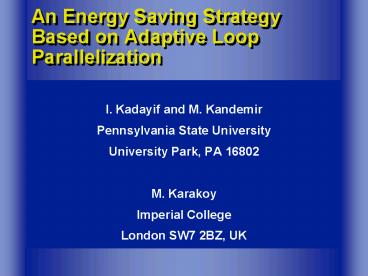An Energy Saving Strategy Based on Adaptive Loop Parallelization - PowerPoint PPT Presentation
1 / 22
Title:
An Energy Saving Strategy Based on Adaptive Loop Parallelization
Description:
Re-synchronization penalty (RP) Energy Model. Components. Data path, clock circuitry, caches and ... Overhead of creating a large number of threads. Shutting ... – PowerPoint PPT presentation
Number of Views:40
Avg rating:3.0/5.0
Title: An Energy Saving Strategy Based on Adaptive Loop Parallelization
1
An Energy Saving Strategy Based on Adaptive Loop
Parallelization
- I. Kadayif and M. Kandemir
- Pennsylvania State University
- University Park, PA 16802
- M. Karakoy
- Imperial College
- London SW7 2BZ, UK
2
Objective
- To evaluate an adaptive loop parallelization
strategy and measure the potential energy savings
when unused processors and their caches are shut
down
3
Outline
- Multi-Processor-on-a Chip (MPoC)
- Our MPoC Architecture
- Energy Model
- Adaptive Loop Parallelization
- Experimental Results
- Conclusion and Future Work
4
MPoC
- Each processors can operate independently
- On-chip-memory (SRAM)
- Synchronization logic
- Processors share data
- I/O and interconnect
- Array-intensive loop dominated applications can
take advantage of MPoC - Source level loop parallelization
5
VLIW/Superscalar Processors
- May provide a certain level of ILP
- Not scalable to provide high level of performance
(e.g., for wireless environments) - Power consumption does not scale linearly (due to
complexity of instruction dispatch, issue units,
etc.)
6
MPoC Examples
- Suns MAJC-5200
- General purpose multi processor systemon a chip
with 2 processors - Multimedia computing and networking applications
- IBM Power4
- More processors on the same chip
7
Our MPoC Architecture
8
Our MPoC Architecture Cont.
- Simple pipelined architecture oneinstruction
issue per cycle - Simple, identical processors
- Data cache and instruction cache
- Low design and verification costs
- A large, off-chip memory (DRAM)
- A simple synchronization mechanism
9
Synchronization Mechanism
8 bit register
CPU0
CPU7
CPU1
10
Objective
- To save leakage energy by shutting off unused
processors and their caches
11
Important Parameters
- Energy reduction factor (ERF)
- Re-synchronization penalty (RP)
12
Energy Model
- Components
- Data path, clock circuitry, caches andoff-chip
memory - SimplePower tool for data path clock circuitry
- 0.35 micron technology
- Analytical cache energy model byShiue et. al.
- 4.95nJ off-chip energy consumptionper access
- Omitted control circuitry
13
Shutting Off Unused Processors
- Only a small subset of processors may generate
best execution time - Intrinsic data dependences
- Overhead of creating a large number of threads
- Shutting off unused processors tosave energy
14
Profiling
15
Profiling Cont.
16
Adaptive Loop Parallelization
- Determining the number of processorsto execute
each loop nest - Dynamic
- Static
- Our approach is static, activation/deactivationat
runtime - Policy
- The criterion to determine the numberof
processors - Execution time based
17
Processor Activation
idle
idle
idle
re-synch
re-synch
active
active
active
v1
v3
v2
18
Normalized Energy Consumption (V2)
19
Performance Penalty (v2)
20
Normalized Energy Consumption (v3)
21
Conclusion and Future Work
- First step for evaluating adaptive
parallelization from energy perspective - Model more accurate communication between
processors - Speculative execution
- Modeling energy consumption of other components
22
For More Information
- www.cse.psu.edu/mdl
- mdl_at_cse.psu.edu































